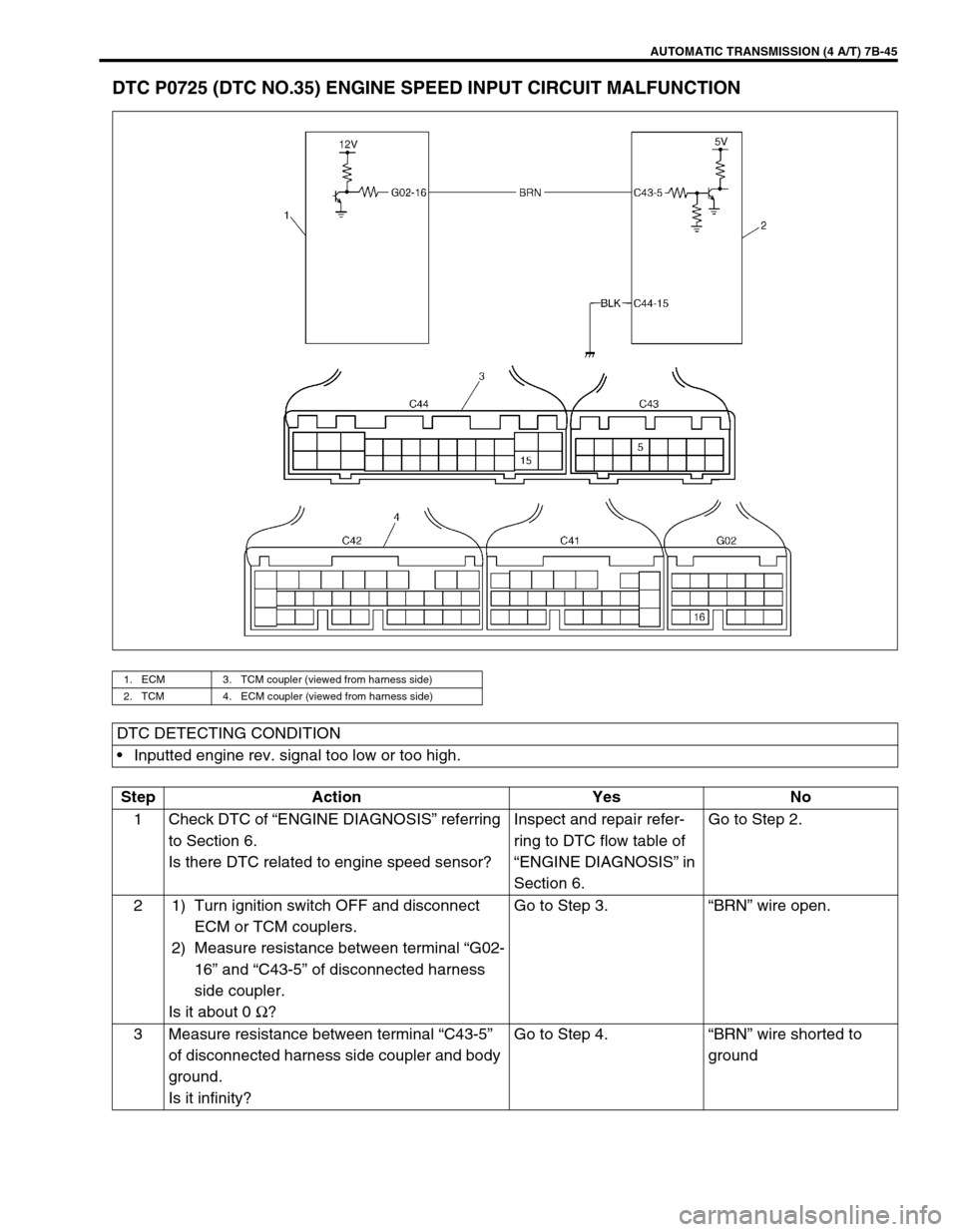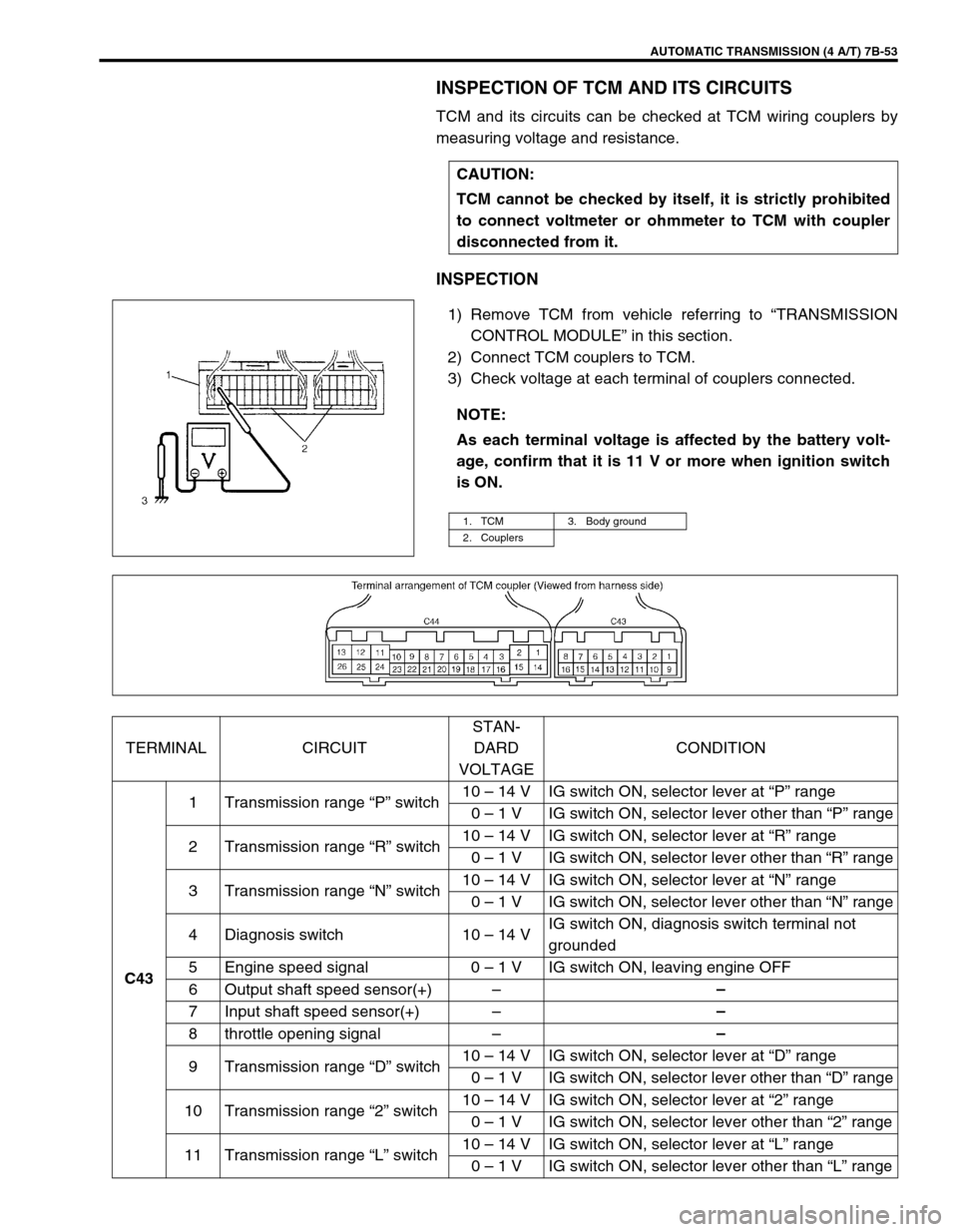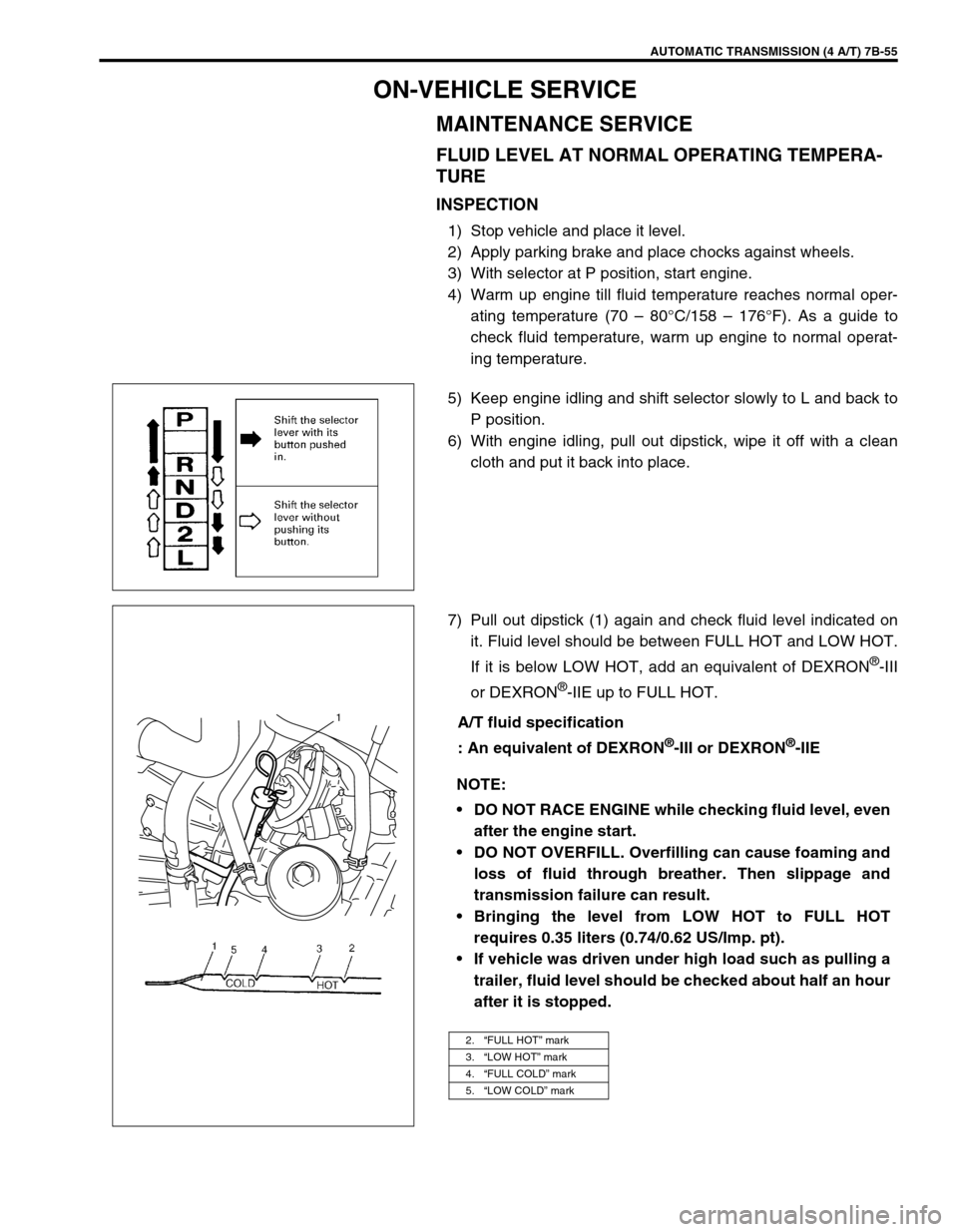ring SUZUKI SWIFT 2000 1.G Transmission Service Repair Manual
[x] Cancel search | Manufacturer: SUZUKI, Model Year: 2000, Model line: SWIFT, Model: SUZUKI SWIFT 2000 1.GPages: 447, PDF Size: 10.54 MB
Page 86 of 447

7B-44 AUTOMATIC TRANSMISSION (4 A/T)
5 While ignition switch ON, check voltage
between terminal “C43-10” and “C44-15” of dis-
connected harness side TCM coupler.
Is it 10 – 14 V at “2” range and 0 V at the other
range?Go to Step 6. Go to Step 7.
6 While ignition switch ON, check voltage
between terminal “C43-11” and “C44-15” of dis-
connected harness side TCM coupler.
Is it 10 – 14 V at “L” range and 0 V at the other
range?Intermittent trouble or
faulty TCM.
Check for intermittent
trouble referring to
“INTERMITTENT AND
POOR CONNECTION”
in Section 0B.Go to Step 7.
7 Check transmission range sensor referring in
this section.
Is it OK?Transmission range sen-
sor wire shorted.
If wire harnesses are OK,
substitute a known-good
TCM and recheck.Replace transmission
range sensor. Step Action Yes No
Page 87 of 447

AUTOMATIC TRANSMISSION (4 A/T) 7B-45
DTC P0725 (DTC NO.35) ENGINE SPEED INPUT CIRCUIT MALFUNCTION
1. ECM 3. TCM coupler (viewed from harness side)
2. TCM 4. ECM coupler (viewed from harness side)
DTC DETECTING CONDITION
Inputted engine rev. signal too low or too high.
Step Action Yes No
1 Check DTC of “ENGINE DIAGNOSIS” referring
to Section 6.
Is there DTC related to engine speed sensor?Inspect and repair refer-
ring to DTC flow table of
“ENGINE DIAGNOSIS” in
Section 6.Go to Step 2.
2 1) Turn ignition switch OFF and disconnect
ECM or TCM couplers.
2) Measure resistance between terminal “G02-
16” and “C43-5” of disconnected harness
side coupler.
Is it about 0 Ω
?Go to Step 3.“BRN” wire open.
3 Measure resistance between terminal “C43-5”
of disconnected harness side coupler and body
ground.
Is it infinity?Go to Step 4.“BRN” wire shorted to
ground
Page 88 of 447

7B-46 AUTOMATIC TRANSMISSION (4 A/T)
4 1) Turn ignition switch OFF and connect ECM
couplers.
2) Turn ignition switch ON and measure volt-
age between terminal “C43-5” of discon-
nected harness side TCM coupler and body
ground.
Is it 10 – 14 V?Intermittent trouble or
faulty ECM or TCM.
Check for intermittent
referring to “INTERMIT-
TENT AND POOR CON-
NECTION” in Section 0A.
If no trouble found, substi-
tute a known-good ECM
or TCM and recheck.“BRN” wire is shorted to
power circuit or faulty
ECM.
If “BRN” wire is OK, sub-
stitute a known-good
ECM and recheck. Step Action Yes No
Page 90 of 447

7B-48 AUTOMATIC TRANSMISSION (4 A/T)
Figure for Step 75 1) Turn ignition switch OFF and connect sen-
sor wire harness coupler.
2) Disconnect TCM couplers.
3) Measure the resistance between terminal
“C44-3” and “C44-16” of disconnected har-
ness side coupler.
Is it infinity?“BLU/RED” or “GRY/
RED” wire open or poor
connection of solenoid
wire harness coupler.Go to Step 7.
6 1) Turn ignition switch OFF and connect sen-
sor wire harness coupler.
2) Disconnect TCM couplers.
3) Measure the resistance between terminal
“C44-3” and “C44-16” of disconnected har-
ness side coupler.
Is it about 0 Ω
or infinity?“BLU/REDl” or “GRY/
RED” wire open, shorted
each other or poor con-
nection of solenoid wire
harness coupler.Go to Step 7.
7 1) Turn ignition switch OFF and connect TCM
couplers.
2) Disconnect solenoid wire harness coupler.
3) Turn ignition switch ON then measure volt-
age between “BLU/RED” wire terminal of
disconnected harness side coupler and
engine ground. (See figure.)
Is it 4 – 6 V?Intermittent trouble or
faulty TCM.
Check for intermittent
referring to “INTERMIT-
TENT AND POOR CON-
NECTION” in Section 0A.
If no trouble found, substi-
tute a known-good TCM
and recheck.“BLU/RED” wire shorted
to power circuit or poor
connection of terminal
“C44-3”.
If wire and connection are
OK, substitute a known-
good TCM. Step Action Yes No
1. BLU/RED wire terminal
Page 91 of 447

AUTOMATIC TRANSMISSION (4 A/T) 7B-49
DTC P0763 (DTC NO.43) SHIFT SOLENOID-C (NO.3) ELECTRICAL
DTC P0768 (DTC NO.45) SHIFT SOLENOID-B (NO.4) ELECTRICAL
DTC P0773 (DTC NO.48) SHIFT SOLENOID-E (NO.5) ELECTRICAL
1. Dropping resistor 4. Shift solenoid-D (No.4) 7. TCM coupler (viewed from harness side)
2. solenoid coupler 5. Shift solenoid-E (No.5)
3. Shift solenoid-C (No.3) 6. TCM
12V
C44-24
C44-13
C44-12
C44-11
C44-25
C44-26
C44-15
1
6
23
4
5
BRN/WHTGRY/BLU
RED/BLU
BLU/ORN
BRN
BLK/YEL
BRN/WHT
BLK/YEL
BRN
BLK
RED
YEL
BRN
7
DTC DETECTING CONDITION
Solenoid output voltage too high or too low differently from TCM order.
Step Action Yes No
1 1) Turn ignition switch OFF and disconnect sole-
noid coupler.
2) Measure resistance between terminal of sole-
noid coupler and transmission ground. (See
figure.)
Is it 2.5 – 3.5 Ω
?Go to Step 2.Solenoid lead wire open or
shorted to ground.
Malfunction of solenoid
valve.
2 1) Disconnect TCM couplers.
2) Measure resistance between terminal of dis-
connected body side solenoid coupler and
terminal “C44-11”, “C44-12” or “C44-13” of
disconnected harness side TCM coupler.
(See chart.)
Is it 6.5 – 8.5 Ω
?Go to Step 3. Inspect dropping resister refer-
ring to “DROPPING RESIS-
TOR” in this section.
If OK, circuit between TCM
and dropping resister or drop-
ping resister and solenoid cou-
pler open.
3 Check continuity between terminal “C44-24”,
“C44-25” or “C44-26” of disconnected TCM cou-
pler and terminal of disconnected body side sole-
noid coupler. (See chart.)
Is there continuity?Go to Step 4. Circuit between TCM and sole-
noid coupler open.
Page 92 of 447

7B-50 AUTOMATIC TRANSMISSION (4 A/T)
Chart for Step 2
Chart for Step 3
Chart for Step 5
Figure for Step 1 and 54 Check continuity between terminal of discon-
nected body side solenoid coupler and transmis-
sion ground with TCM, dropping resister and
solenoid couplers disconnected.
Is there continuity?Circuit between
TCM and transmis-
sion shorted to
ground.Go to Step 5.
5 Check continuity between terminal of discon-
nected body side dropping resistor coupler and
transmission ground. (See chart.)
Is there continuity?Circuit between
TCM and dropping
resister is shorted
to ground.Intermittent trouble or faulty
TCM.
Check for intermittent referring
to “INTERMITTENT AND
POOR CONNECTION” in Sec-
tion 0A. If no trouble found,
substitute a known-good TCM
and recheck.
Solenoid TCM terminal No.Solenoid coupler lead wire color
(body side)
C (No.3) C44-11 BRN
D (No.4) C44-12 BLK/YEL
E (No.5) C44-13 BRN/WHT
Solenoid TCM terminal No.Solenoid coupler lead wire color
(body side)
C (No.3) C44-24 BRN
D (No.4) C44-25 BLK/YEL
E (No.5) C44-26 BRN/WHT
Solenoid TCM terminal No.Dropping resistor lead wire color
(body side)
C (No.3) C44-11 GRY/BLU
D (No.4) C44-12 RED/BLU
E (No.5) C44-13 BLU/ORN
1. Solenoid coupler
2. Terminal for shift solenoid-C (No.3)
3. Terminal for shift solenoid-D (No.4)
4. Terminal for shift solenoid-E (No.5)
5. Transmission range sensor (Shift switch)
6. Dropping resistor terminal for shift solenoid-C (No.3)
7. Dropping resistor terminal for shift solenoid-D (No.4)
8. Dropping resistor terminal for shift solenoid-E (No.5)
9. Dropping resistor coupler
Step Action Yes No
Page 93 of 447

AUTOMATIC TRANSMISSION (4 A/T) 7B-51
DTC P1709 (DTC NO.51) ENGINE COOLANT TEMPERATURE/BAROMETRIC PRESSURE
SIGNAL CIRCUIT
1. ECM 3. TCM coupler (viewed from harness side)
2. TCM 4. ECM coupler (viewed from harness side)
DTC DETECTING CONDITION
Engine coolant temperature/barometric pressure signal voltage too low although A/T fluid temperature is
normal operating temperature and engine rev. is standard.
Step Action Yes No
1 Check DTC referring to “ENGINE DIAGNOSIS”
in Section 6.
Is any DTC detected?Inspect and repair refer-
ring to DTC flow table in
Section 6.Go to Step 2.
2 1) Turn ignition switch OFF and disconnect
TCM and ECM couplers.
2) Measure resistance between terminal “C44-
18” of disconnected harness side TCM cou-
pler and body ground.
Is it infinity?Go to Step 3.“WHT/BLK” wire shorted
to ground.
3 1) Turn ignition switch OFF and connect TCM
couplers.
2) Turn ignition switch ON and check voltage
between terminal “C44-18” and body
ground.
Is it 0V?Substitute a known-good
TCM and recheck.Substitute a know-good
ECM and recheck.
Page 94 of 447

7B-52 AUTOMATIC TRANSMISSION (4 A/T)
DTC P0702/P1702 (DTC No.52)TRANSMISSION CONTROL SYSTEM ELECTRICAL OR
INTERNAL MALFUNCTION OF TCM
1. TCM 3. A/T relay
2. Ignition switch 4. TCM coupler (viewed from harness side)
DTC DETECTING CONDITION
Relay output voltage too high although TCM orders the relay to turn OFF or relay output voltage too low
although TCM orders the relay to turn on.
Incorrect calculations of checking TCM programmed data indicated.
Step Action Yes No
1 1) Turn ignition switch ON.
2) Erase all DTCs referring to “HOW TO
CLEAR DTC” in this section.
3) Turn ignition switch OFF.
4) Turn ignition switch ON once again and
check for any DTC.
Is it DTC P1702 (DTC No.52) or P0702 (DTC
No.52)?Replace TCM. Could be a temporary
malfunction of the TCM.
Page 95 of 447

AUTOMATIC TRANSMISSION (4 A/T) 7B-53
INSPECTION OF TCM AND ITS CIRCUITS
TCM and its circuits can be checked at TCM wiring couplers by
measuring voltage and resistance.
INSPECTION
1) Remove TCM from vehicle referring to “TRANSMISSION
CONTROL MODULE” in this section.
2) Connect TCM couplers to TCM.
3) Check voltage at each terminal of couplers connected.CAUTION:
TCM cannot be checked by itself, it is strictly prohibited
to connect voltmeter or ohmmeter to TCM with coupler
disconnected from it.
NOTE:
As each terminal voltage is affected by the battery volt-
age, confirm that it is 11 V or more when ignition switch
is ON.
1. TCM 3. Body ground
2. Couplers
TERMINAL CIRCUITSTAN-
DARD
VOLTAGECONDITION
C431 Transmission range “P” switch10 – 14 V IG switch ON, selector lever at “P” range
0 – 1 V IG switch ON, selector lever other than “P” range
2 Transmission range “R” switch10 – 14 V IG switch ON, selector lever at “R” range
0 – 1 V IG switch ON, selector lever other than “R” range
3 Transmission range “N” switch10 – 14 V IG switch ON, selector lever at “N” range
0 – 1 V IG switch ON, selector lever other than “N” range
4 Diagnosis switch 10 – 14 VIG switch ON, diagnosis switch terminal not
grounded
5 Engine speed signal 0 – 1 V IG switch ON, leaving engine OFF
6 Output shaft speed sensor(+)––
7 Input shaft speed sensor(+)––
8 throttle opening signal––
9 Transmission range “D” switch10 – 14 V IG switch ON, selector lever at “D” range
0 – 1 V IG switch ON, selector lever other than “D” range
10 Transmission range “2” switch10 – 14 V IG switch ON, selector lever at “2” range
0 – 1 V IG switch ON, selector lever other than “2” range
11 Transmission range “L” switch10 – 14 V IG switch ON, selector lever at “L” range
0 – 1 V IG switch ON, selector lever other than “L” range
Page 97 of 447

AUTOMATIC TRANSMISSION (4 A/T) 7B-55
ON-VEHICLE SERVICE
MAINTENANCE SERVICE
FLUID LEVEL AT NORMAL OPERATING TEMPERA-
TURE
INSPECTION
1) Stop vehicle and place it level.
2) Apply parking brake and place chocks against wheels.
3) With selector at P position, start engine.
4) Warm up engine till fluid temperature reaches normal oper-
ating temperature (70 – 80°C/158 – 176°F). As a guide to
check fluid temperature, warm up engine to normal operat-
ing temperature.
5) Keep engine idling and shift selector slowly to L and back to
P position.
6) With engine idling, pull out dipstick, wipe it off with a clean
cloth and put it back into place.
7) Pull out dipstick (1) again and check fluid level indicated on
it. Fluid level should be between FULL HOT and LOW HOT.
If it is below LOW HOT, add an equivalent of DEXRON
®-III
or DEXRON
®-IIE up to FULL HOT.
A/T fluid specification
: An equivalent of DEXRON
®-III or DEXRON®-IIE
NOTE:
DO NOT RACE ENGINE while checking fluid level, even
after the engine start.
DO NOT OVERFILL. Overfilling can cause foaming and
loss of fluid through breather. Then slippage and
transmission failure can result.
Bringing the level from LOW HOT to FULL HOT
requires 0.35 liters (0.74/0.62 US/Imp. pt).
If vehicle was driven under high load such as pulling a
trailer, fluid level should be checked about half an hour
after it is stopped.
2.“FULL HOT” mark
3.“LOW HOT” mark
4.“FULL COLD” mark
5.“LOW COLD” mark
1